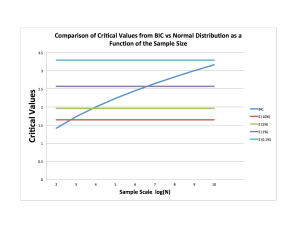 An interesting problem when analyzing Big Data is whether one should report the statistical significance of the estimated coefficients at the 1% level, instead of the more conventional 5% level. Intuitively a more conservative approach seems reasonable, but how do we decide exactly how conservative we ought to be?
An interesting problem when analyzing Big Data is whether one should report the statistical significance of the estimated coefficients at the 1% level, instead of the more conventional 5% level. Intuitively a more conservative approach seems reasonable, but how do we decide exactly how conservative we ought to be?
It has been recognized for some time that when using large data it becomes “too easy” to reject the null hypothesis of no statistical significance, since confidence intervals are (Granger, 1998). The problem with a standard t-test in large samples is that it is replaced by its asymptotic form and the critical values are drawn from the Normal distribution. As a result, for large sample sizes the critical value for testing at the 95% significance level does not increase with the sample size. One possibility for addressing this problem is to let the critical value be a function of the sample size.
My colleague, Carlos Lamarche, at the University of Kentucky, pointed out this week that one can think about this as a testing problem for nested models. Cameron and Trivedi (2005) suggest using the Bayesian Information Criterion (BIC) for which the penalty increases with the sample size. Using the BIC for testing the significance of one variable is identical to using a two-sided t-test critical value of .
The plot shows how the critical value increases with the scale of the data and how this compares with the standard critical values for the t-test at different levels of significance. Using the BIC suggests using critical values greater than 2 for sample sizes larger than 1000. When using Big Data with over 1M observations, a critical value equivalent to a t-test at the 99% or even 99.9% seems advisable.
Granger, C. W. J. (1998): “Extracting information from mega-panels and high-frequency data,” Statistica Neerlandica, 52(3), 258–272.
Cameron, C. A., and P. K. Trivedi (2005): Microeconometrics: Methods and applications. New York, NY: Cambridge University Press.